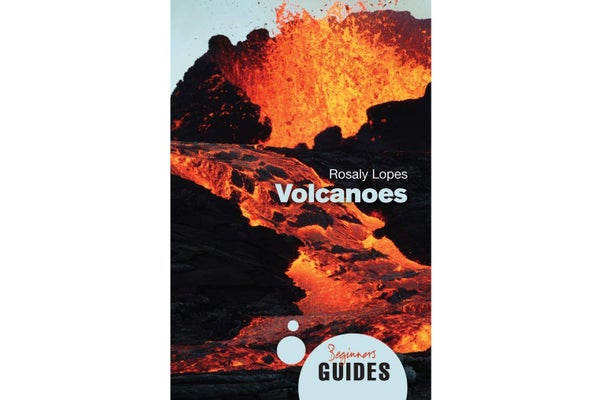This article was published in Scientific American’s former blog network and reflects the views of the author, not necessarily those of Scientific American
Since Kilauea's hawt eruption action moved from Pu'u O'o to Puna, interest in volcanoes has been running hot as the lava in the Fissure 8 channel. I'm all about ensuring folks get the genuine info on the earth sciences, so I picked up a copy of Rosaly Lopes's Volcanoes: A Beginner's Guide to review for you.
You might be that person who's just caught the volcano bug, or a long-time lover of the good science of mountains that go boom who wants a good refresher. Maybe you're that person eager to hook someone on the earth sciences, and know that fire-flinging mountains are a near-certain means to that end. Or you may know someone who's avidly following the Kilauea coverage and could now use a handy primer to help them make sense of it all. It's even possible you may need to show your friend or family member that there's really no need to choose between astronomy and geology as their career – they can have it all! This short book will serve all of these purposes handily.
And the way it's written makes it a great read for anyone who's over the age of picture books. I know precocious ten year-olds who could manage this book, and yet, it doesn't talk down.
On supporting science journalism
If you're enjoying this article, consider supporting our award-winning journalism by subscribing. By purchasing a subscription you are helping to ensure the future of impactful stories about the discoveries and ideas shaping our world today.
As far as expertise: Dr. Lopes not only works for NASA, she's discovered enough active volcanoes to make it into the Guinness Book of World Records. So, y'know, she knows her stuff.
The book is laid out beautifully and is basically a complete introductory course on volcanoes. It starts out with the absolute basics: what volcanoes are and how they erupt. Then Dr. Lopes takes us through the various eruption types, starting with the low-explosivity ones like Hawaiian and Icelandic eruptions, ramping up the violence scale clear to ultraplinian. Each of these sections includes a description of the eruption type, then explores historical volcanic eruptions of that type.
Once you've been given a good handle on the eruption types, Dr. Lopes advises how you can safely see such eruptions for yourself. If safe viewing of the actual event is a no-go, she explains how to view the aftermath instead. This is something no other book on volcanoes has, as far as I'm aware, and it's super neat. It moves volcanic eruptions from the experience only vicariously column to the something we can see in real life! column. I love that.
A few chapters are devoted to mudflows, degassing, and geothermal areas, which are really important volcanic goings-on to know about. I'm pretty sure people are more aware of the use of geothermal areas than in the past, but knowing more about how they originate is awesome. And how many people think of mud when they think of volcanoes? More certainly need to, because mudflows are one of the most deadly volcanic hazards.
Speaking of mud, you'll find actual mud volcanoes in the chapter on exotic volcanic activity. I didn't know about mud volcanoes until I was in my 30s and feel so cheated out of years of marveling at erupting mud. So definitely buy this book for a teenager. There's also carbonatite lava, plus under-the-sea volcanism and hydromagmatic eruptions, which are neato.
Two meaty chapters take us out of this world to explore volcanoes on other worlds. This is where Dr. Lopes's NASA expertise puts on its sunglasses and shines. She shows us how it gets deliciously weird out there, what with volcanoes of types we'll never see on Earth. Our close neighbor Venus has some really wild volcanic landforms with evocative names like arachnoids and anemones. There are volcanoes that erupt lavas made of water and ammonia or methane, which behave somewhat like molten rock does here on Earth. And it's quite possible that some of the volcanism on distant worlds is driven not by plate tectonics or tidal friction, but sunlight. Freaking solar-powered volcanoes. I love this universe!
Dr. Lopes ends with a short chapter on volcanic research, including planetary studies, which rounds the book out nicely.
Is it a perfect book? Of course not. For example, it could've been at least 110% longer and still not been long enough. But if you're looking for a good introductory book on volcanoes, it's hard to go wrong here. This is a remarkably comprehensive book for its brevity. It's now going to be my go-to recommendation when people ask where to start. Go thee forth and get a copy.

Credit: Oneworld Publications
